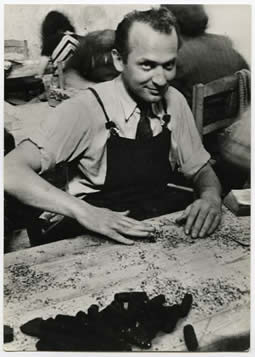
The Académie royale de peinture et de sculpture was founded in 1648 in Paris, France. It was the premier art institution of France during the latter part of the Ancien Régime until it was abolished in 1793 during the French Revolution. It included most of the important painters and sculptors, maintained almost total control of teaching and exhibitions, and afforded its members preference in royal commissions.

Jean-Paul Riopelle, was a Canadian painter and sculptor from Quebec. He had one of the longest and most important international careers of the sixteen signatories of the Refus Global, the 1948 manifesto that announced the Quebecois artistic community's refusal of clericalism and provincialism. He is best known for his abstract painting style, in particular his "mosaic" works of the 1950s when he famously abandoned the paintbrush, using only a palette knife to apply paint to canvas, giving his works a distinctive sculptural quality. He became the first Canadian painter since James Wilson Morrice to attain widespread international recognition.
Michel Saloff Coste is an artist and professor at the École des Hautes Études Commerciales, and co-founder of the Club of Budapest France, an international non-profit organisation dedicated to leading citizens into discussing complex global issues.

Xavier Noiret-Thomé is a French painter.
Philippe Walter Marie Dodard is a Haitian graphic artist and painter. His works have been exhibited throughout Europe and the Americas.

Philippe Lardy is a Swiss painter, illustrator, art director and a graphic novelist. He attends the School of Visual Arts in the 1980s in New York.
Jean-Michel Sanejouand was a French artist. His work ranged from environments to monumental sculptures, from readymade-like objects, to paintings of oneiric landscapes in which (usually) one of his sculptures stands.
Carlos Ginzburg is a conceptual artist and theoretician born in 1946 in La Plata, Argentina. He studied philosophy and social theory.
Fernand Toupin was a Québécois abstract painter best known as a first-generation member of the avant-garde movement known as Les Plasticiens. Like other members of the group, his shaped paintings drew upon the tradition of geometric abstraction, and he cited Mondrian as a forerunner. In 1959, Toupin began working with a more lyrical, though abstract, way of painting. The last decade of his career saw his return to geometric abstraction. Like Jean-Paul Mousseau, Toupin created works which lay outside the standard boundaries of art such as his stage sets for ballets.

Richard Texier is a French painter and sculptor. He lives and works in Paris.

Pierre Schwarz is a contemporary Belgian painter and engraver, neo-expressionist and muralist.

William MacKendree is an American artist. He was born in Augusta, Georgia in 1948. He studied Philosophy and Visual Arts at Georgia State University in Atlanta. Following the completion of his university degrees, he left the U.S. to live and work in Greece between 1975 and 1982.
Rachid Khimoune is a French sculptor of Algerian descent born on April 7, 1953, in Decazeville, Aveyron.
ShaficAbboud was a Lebanese painter. He studied at the Académie Libanaise des Beaux-Arts ALBA and left to Paris in 1947. Although he spent most of his life in France, he is considered as one of the most influential Lebanese artists of the 20th century.

Olivier Masmonteil is a French artist. He studied at the École des Beaux-Arts de Bordeaux from 1996 to 1999. As a painter, Olivier Masmonteil dedicates his work exclusively to landscapes. While offering a variety of treatment, the paintings of Olivier Masmonteil assume a thematic unity which the landscape is both the substance and form, subject and object, the content and container. Globetrotter artist, he has started a second world tour in Asia and South America.

Speedy Graphito is a French painter who is considered a pioneer of the French Street Art movement.
Philippe Richard is a French artist, based in Paris, France. He lived New York from 1996 to 1999. He has been very close to some American painters such as Joan Mitchell and Shirley Jaffe. Some of his work resides in the THEODORE:Art gallery in Brooklyn, New York.

Didier Ottinger, born in Nancy in 1957, is a French museum curator, art critic and author. He is known for organizing exhibitions and publishing books on modern and contemporary painting. He is now assistant director of the Centre Pompidou at the Musée national d'art moderne in Paris.

Jacques Hérold was a prominent surrealist painter born in Piatra Neamț, Romania.

Stéphane Kreienbühl, known as Stéphane Belzère, is a Franco-Swiss painter. He lives and works between Paris and Basel.












